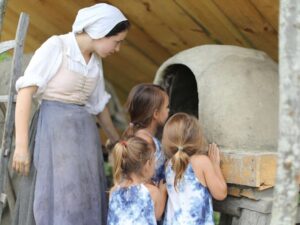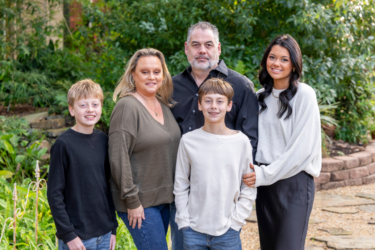When I think about Thanksgiving, my mind conjures up images of pies, parades, and Pilgrims. I realize that most people think of turkeys, but I live in Massachusetts where Pilgrims are kind of a big deal.
There’s even a dedicated museum for the Pilgrims called Plimoth (yes that’s how they spell it) Plantation. Since I didn’t grow up in Massachusetts, I never went. I’m not sure why my Boston-born husband failed to go, but once we had three kids, we decided it was a must-see.
I probably should have done some research about the place before our visit, but when you’re the mom of twins and a daughter, all under the age of five, you don’t have time.
Instead, you’re like a doomsday prepper–always in survival mode. Any research you conduct is related to identifying all the nearest bathrooms in a 25-mile radius or packing enough snacks to satisfy the hunger of a pride of lions. Because let’s face it, if your kids experience even a pang of hunger, it becomes a five-alarm fire situation with all hands-on deck. Just like you have a fire extinguisher under your sink to put out a fire, you need a bag of food to prevent an embarrassing hunger induced meltdown.
We arrived at Plimoth Plantation with a double stroller and our backpack of food rations only to realize that the pathways were all dirt, which was not easy to maneuver. But we forged ahead as any good Pilgrim would do.
Like Disney World, there are different sections of Plimoth Plantation–one for the Pilgrims and the other for the Native Americans. After meandering down the gravel path, we found ourselves in the 17th-Century English Village–land of the Pilgrims. We first noticed a row of small wood houses with thatched roofs and people dressed in outfits like the ones worn by my favorite characters in Little House on the Prairie.
A man with a brown felt hat and socks up to his knees greeted us by saying, “Good morrow.”
At first, I thought maybe this man had an unusual thick Boston accent, but after glancing over at my Bostonian husband who had a dumbfounded look on his face, I knew it wasn’t.
“Hello,” we replied in unison.
“Pray pardon me,” the Pilgrim said.
“Oh, I get it. You are supposed to be a Pilgrim. This should be fun,” said my husband.
And then the next hour or so he tried to “trip up” the Pilgrim actors by asking them a trillion or so questions. Those actors were good because they never strayed from the year 1622.
After visiting the village, we continued along the path that led to the Native American Wampanoag Homesite. The first man we encountered was dressed in deerskin attire. My husband was eager to play 20 questions.
Now here is where it would have been helpful to do some research before visiting. Besides having to push a stroller with tiny wheels down a bumpy path, or as the Pilgrims would say, a jumble-gut lane, it would have been helpful to know a little information about the place, as you will soon see.
“So how do you feel about your Pilgrim neighbors down the way?” my husband asked the Wampanoag man.
“This homesite is in the present day. We are not actors and I’m in the Wampanoag tribe.”
Dead silence. And then he awkwardly apologized for his faux pas. Then, we ventured over to Plymouth Rock, where it all began for the Pilgrims.
“That can’t be it,” my husband said.
“Uh, that’s what the sign says,” I replied.
I must admit, I was envisioning a huge boulder, not a rock smaller than my snack stash. It was a bit disappointing.
Speaking of snacks, I noticed my supplies were running dangerously low, which meant it was time to return home–stat!
So now you can understand why Thanksgiving makes me think of the Pilgrims. All that Thanksgiving food almost rivals my snack stash backpack we brought to Plimoth Plantation. Oh, and of course, there is the fact that they had the first Thanksgiving, but if I’m being honest, I can’t help but think of the food-snack parallel.
On that note, I gotta go start prepping for our next adventure. “Fare thee well.” That’s Pilgrim’s speak for “Goodbye.” I wonder what the Pilgrim word is for snacks. ■





